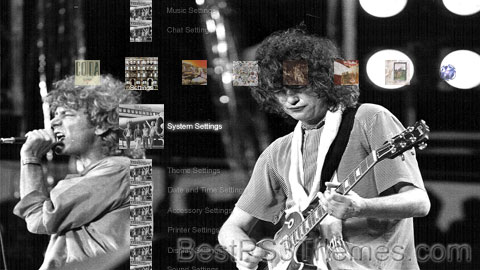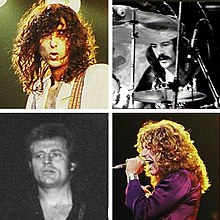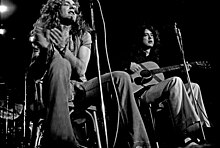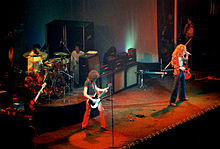Led Zeppelin theme by Kris De Sha
Download: LedZeppelin.p3t

(1 background)
Led Zeppelin | |
|---|---|
 | |
| Background information | |
| Origin | London, England |
| Genres | |
| Years active | 1968–1980[nb 1] |
| Labels | |
| Spinoffs | The Honeydrippers |
| Spinoff of | The Yardbirds[1] |
| Past members | |
| Website | ledzeppelin |
Led Zeppelin were an English rock band formed in London in 1968. The group comprised vocalist Robert Plant, guitarist Jimmy Page, bassist and keyboardist John Paul Jones, and drummer John Bonham. With a heavy, guitar-driven sound, they are cited as one of the progenitors of hard rock and heavy metal, although their style drew from a variety of influences, including blues and folk music. Led Zeppelin have been credited as significantly impacting the nature of the music industry, particularly in the development of album-oriented rock (AOR) and stadium rock.
Evolving from the Yardbirds where Page was lead guitarist, and originally named the New Yardbirds, Led Zeppelin signed a deal with Atlantic Records that gave them considerable artistic freedom. Initially unpopular with critics, they achieved significant commercial success with eight studio albums over ten years. Their 1969 debut, Led Zeppelin, was a top-ten album in several countries and featured such tracks as "Good Times Bad Times", "Dazed and Confused" and "Communication Breakdown". Led Zeppelin II (1969), their first number-one album, included "Whole Lotta Love" and "Ramble On". In 1970, they released Led Zeppelin III which opened with "Immigrant Song". Their untitled fourth album, commonly known as Led Zeppelin IV (1971), is one of the best-selling albums in history with 37 million copies sold. The album includes "Black Dog", "Rock and Roll" and "Stairway to Heaven", with the latter being among the most popular and influential works in rock history. Houses of the Holy (1973) yielded "The Song Remains the Same" and "Over the Hills and Far Away". Physical Graffiti (1975), a double album, featured "The Rover" and "Kashmir".
Page composed most of Led Zeppelin's music, having a writing credit on every song apart from three tracks on the band's final album, In Through the Out Door (1979), while Plant wrote most of the lyrics. Jones occasionally added keyboard-focused contributions to compositions, particularly on the final album. The latter half of their career saw a series of record-breaking tours that earned the group a reputation for excess and debauchery. Although they remained commercially and critically successful, their touring and output, which included Presence (1976) and In Through the Out Door, declined in the late 1970s. After Bonham's death in 1980, the group disbanded, feeling that they would not be "Led Zeppelin" without him. Since then, the surviving former members have sporadically collaborated and participated in one-off concerts. The most successful of these was the 2007 Ahmet Ertegun Tribute Concert in London, with Bonham's son Jason Bonham on drums.
Led Zeppelin are one of the best-selling music artists of all time; their total record sales are estimated to be between 200 and 300 million units worldwide. They achieved eight consecutive UK number-one albums and six number-one albums on the US Billboard 200, with five of their albums certified Diamond in the US by the Recording Industry Association of America (RIAA). Rolling Stone magazine described them as "the heaviest band of all time", "the biggest band of the Seventies", and "unquestionably one of the most enduring bands in rock history".[2] They were inducted into the Rock and Roll Hall of Fame in 1995; the museum's biography of the band states that they were "as influential" during the 1970s as the Beatles were during the 1960s.[3]
History[edit]
Formation: 1966–1968[edit]

In 1966, London-based session guitarist Jimmy Page joined the blues-influenced rock band the Yardbirds to replace bassist Paul Samwell-Smith. Page soon switched from bass to lead guitar, creating a dual lead guitar line-up with Jeff Beck. Following Beck's departure in October 1966, the Yardbirds became a four-piece with Page as the sole guitarist. This new line-up recorded an album, Little Games, in 1967, before embarking on a tour of the United States, during which they performed several songs which would later be part of Led Zeppelin's early repertoire, including covers of Johnny Burnette's "Train Kept A-Rollin'" and "Dazed and Confused", a song originally written and recorded by Jake Holmes.[4] In early April 1968, the Yardbirds recorded a number of tracks at Columbia Studios in New York City, including a Page composition initially titled "Knowing That I'm Losing You", which would eventually be re-recorded by Led Zeppelin as "Tangerine".[5][6]
The Yardbirds' 1968 tour proved to be exhausting for the band. Drummer Jim McCarty and vocalist Keith Relf aimed to embark in a more acoustic direction, forming a folk rock duo called Together,[7] whereas Page wanted to continue the heavier blues-based sound of the Yardbirds. Page, with the support of the Yardbirds' new manager Peter Grant, planned to form a supergroup with Beck and himself on guitars, and the Who's Keith Moon and John Entwistle on drums and bass, respectively.[8] Vocalists Steve Winwood and Steve Marriott were also considered for the project.[9] The group never formed, although Page, Beck, and Moon did record a song together in 1966, "Beck's Bolero", in a session that also included bassist-keyboardist John Paul Jones.[10]
The Yardbirds played their final gig on 14 July 1968 at Luton College of Technology in Bedfordshire.[11] They were still committed to several concerts in Scandinavia, so drummer Jim McCarty and vocalist Keith Relf authorised Page and bassist Chris Dreja to use the Yardbirds' name to fulfill the band's obligations. Page and Dreja began putting a new line-up together. Page's first choice for the lead singer was Terry Reid, but Reid declined the offer and suggested Robert Plant, a singer for the Band of Joy and Hobbstweedle.[12] Plant eventually accepted the position, recommending former Band of Joy drummer John Bonham.[13] John Paul Jones enquired about the vacant position of bass guitarist, at the suggestion of his wife, after Dreja dropped out of the project to become a photographer.[14][nb 2] Page had known Jones since they were both session musicians, and agreed to let him join as the final member.[16]

In August 1968, the four played together for the first time in a room below a record store on Gerrard Street in London.[17] Page suggested that they attempt "Train Kept A-Rollin'", originally a jump blues song popularised in a rockabilly version by Johnny Burnette, which had been covered by the Yardbirds. "As soon as I heard John Bonham play", Jones recalled, "I knew this was going to be great ... We locked together as a team immediately".[18] Before leaving for Scandinavia, the group took part in a recording session for the P. J. Proby album Three Week Hero. The album's track "Jim's Blues", with Plant on harmonica, was the first studio track to feature all four future members of Led Zeppelin.[19]
The band completed the Scandinavian tour as the New Yardbirds, playing together for the first time in front of a live audience at Gladsaxe Teen Club at the Egegård School (today Gladsaxe School) festive hall, Gladsaxe, Denmark, on 7 September 1968.[19] Later that month, they began recording their first album, which was based on their live set. The album was recorded and mixed in nine days, and Page covered the costs.[20] After the album's completion, the band were forced to change their name after Dreja issued a cease and desist letter, stating that Page was allowed to use the New Yardbirds moniker for the Scandinavian dates only.[21] One account of how the new band's name was chosen held that Moon and Entwistle had suggested that a supergroup with Page and Beck would go down like a "lead balloon", an idiom for being very unsuccessful or unpopular.[22] The group dropped the 'a' in lead at the suggestion of Peter Grant, so that those unfamiliar with the term would not pronounce it "leed".[23] The word "balloon" was replaced by "zeppelin", a word which, according to music journalist Keith Shadwick, brought "the perfect combination of heavy and light, combustibility and grace" to Page's mind.[22]
Grant secured a $143,000 advance contract ($1,253,000 today) from Atlantic Records in November 1968—at the time, the biggest deal of its kind for a new band.[24] Atlantic was a label with a catalogue of mainly blues, soul, and jazz artists, but in the late 1960s, it began to take an interest in British progressive rock acts. At the recommendation of British singer Dusty Springfield, a friend of Jones who at the time was completing her first Atlantic album, Dusty in Memphis, record executives signed Led Zeppelin without having ever seen them.[25] Under the terms of their contract, the band had autonomy in deciding when they would release albums and tour and had the final say over the contents and design of each album. They would also decide how to promote each release and which tracks to release as singles. They formed their own company, Superhype, to handle all publishing rights.[17]
Early years: 1968–1970[edit]
Still billed as the New Yardbirds, the band began their first tour of the UK on 4 October 1968, when they played at the Mayfair Ballroom in Newcastle upon Tyne.[26] Their first show as Led Zeppelin was at the University of Surrey in Battersea on 25 October.[27] Tour manager Richard Cole, who would become a major figure in the touring life of the group, organised their first North American tour at the end of the year.[28][nb 3] Their debut album, Led Zeppelin, was released in the US during the tour on 13 January 1969, and peaked at number 10 on the Billboard chart;[30] it was released in the UK, where it peaked at number 6, on 31 March.[31] According to Steve Erlewine, the album's memorable guitar riffs, lumbering rhythms, psychedelic blues, groovy, bluesy shuffles and hints of English folk music made it "a significant turning point in the evolution of hard rock and heavy metal".[32]

In their first year, Led Zeppelin completed four US and four UK concert tours, and also released their second album, Led Zeppelin II. Recorded mostly on the road at various North American studios, it was an even greater commercial success than their first album and reached the number one chart position in the US and the UK.[33] The album further developed the mostly blues-rock musical style established on their debut release, creating a sound that was "heavy and hard, brutal and direct", and which would be highly influential and frequently imitated.[34] Steve Waksman has suggested that Led Zeppelin II was "the musical starting point for heavy metal".[35]
The band saw their albums as indivisible, complete listening experiences, disliking the re-editing of existing tracks for release as singles. Grant maintained an aggressive pro-album stance, particularly in the UK, where there were few radio and TV outlets for rock music. Without the band's consent, however, some songs were released as singles, particularly in the US.[36] In 1969, an edited version of "Whole Lotta Love", a track from their second album, was released as a single in the US. It reached number four in the Billboard chart in January 1970, selling over one million copies and helping to cement the band's popularity.[37] The group also increasingly shunned television appearances, citing their preference that their fans hear and see them in live concerts.[38][39]
Following the release of their second album, Led Zeppelin completed several more US tours. They played initially in clubs and ballrooms, and then in larger auditoriums as their popularity grew.[13] Some early Led Zeppelin concerts lasted more than four hours, with expanded and improvised live versions of their repertoire. Many of these shows have been preserved as bootleg recordings. It was during this period of intensive concert touring that the band developed a reputation for off-stage excess.[40][nb 4]
In 1970, Page and Plant retired to Bron-Yr-Aur, a remote cottage in Wales, to commence work on their third album, Led Zeppelin III.[42] The result was a more acoustic style that was strongly influenced by folk and Celtic music, and showcased the band's versatility. The album's rich acoustic sound initially received mixed reactions, with critics and fans surprised at the turn from the primarily electric arrangements of the first two albums, further fuelling the band's hostility to the musical press.[43] It reached number one in the UK and US charts, but its stay would be the shortest of their first five albums.[44] The album's opening track, "Immigrant Song", was released as a US single in November 1970 against the band's wishes, reaching the top twenty on the Billboard chart.[45]
"The Biggest Band in the World": 1970–1975[edit]

During the 1970s, Led Zeppelin reached new heights of commercial and critical success that made them one of the most influential groups of the era, eclipsing their earlier achievements.[46][40] The band's image also changed as the members began to wear elaborate, flamboyant clothing, with Page taking the lead on the flamboyant appearance by wearing a glittering moon-and-stars outfit. Led Zeppelin changed their show by using things such as lasers, professional light shows and mirror balls.[47] They began travelling in a private jet airliner, a Boeing 720 (nicknamed the Starship), rented out entire sections of hotels (including the Continental Hyatt House in Los Angeles, known colloquially as the "Riot House"), and became the subject of frequently repeated stories of debauchery. One involved John Bonham riding a motorcycle through a rented floor of the Riot House,[48] while another involved the destruction of a room in the Tokyo Hilton, leading to the group being banned from that establishment for life.[49] Although Led Zeppelin developed a reputation for trashing their hotel suites and throwing television sets out of the windows, some suggest that these tales have been exaggerated. According to music journalist Chris Welch, "[Led Zeppelin's] travels spawned many stories, but it was a myth that [they] were constantly engaged in acts of wanton destruction and lewd behaviour".[50]
Led Zeppelin released their fourth album on 8 November 1971. It is variously referred to as Led Zeppelin IV, Untitled, IV, or, due to the four symbols appearing on the record label, as Four Symbols, Zoso or Runes.[51] The band had wanted to release the fourth album with no title or information, in response to the music press "going on about Zeppelin being a hype", but the record company wanted something on the cover, so in discussions, it was agreed to have four symbols to represent both the four members of the band and that it was the fourth album.[52] With 37 million copies sold, Led Zeppelin IV is one of the best-selling albums in history, and its massive popularity cemented Led Zeppelin's status as superstars in the 1970s.[53][54] By 2021, it had sold 24 million copies in the United States alone.[55] The track "Stairway to Heaven", never released as a single, was the most requested and most played song on American rock radio in the 1970s.[56] The group followed up the album's release with tours of the UK, Australasia, North America, Japan, and the UK again from late 1971 through early 1973.

Led Zeppelin's next album, Houses of the Holy, was released in March 1973. It featured further experimentation by the band, who expanded their use of synthesisers and mellotron orchestration. The predominantly orange album cover, designed by the London-based design group Hipgnosis, depicts images of nude children climbing the Giant's Causeway in Northern Ireland. Although the children are not shown from the front, the cover was controversial at the time of the album's release. As with the band's fourth album, neither their name nor the album title was printed on the sleeve.[57]
Houses of the Holy topped charts worldwide,[58] and the band's subsequent concert tour of North America in 1973 broke records for attendance, as they consistently filled large auditoriums and stadiums. At Tampa Stadium in Florida, they played to 56,800 fans, breaking the record set by the Beatles' 1965 Shea Stadium concert and grossing $309,000.[59] Three sold-out shows at Madison Square Garden in New York City were filmed for a motion picture, but the theatrical release of this project (The Song Remains the Same) was delayed until 1976. Before the final night's performance, $180,000 ($1,235,000 today) of the band's money from gate receipts was stolen from a safe deposit box at the Drake Hotel.[60]

In 1974, Led Zeppelin took a break from touring and launched their own record label, Swan Song, named after an unreleased song. The record label's logo is based on a drawing called Evening: Fall of Day (1869) by William Rimmer. The drawing features a figure of a winged human-like being interpreted as either Apollo or Icarus.[61][62][63] The logo can be found on Led Zeppelin memorabilia, especially T-shirts. In addition to using Swan Song as a vehicle to promote their own albums, the band expanded the label's roster, signing artists such as Bad Company, the Pretty Things and Maggie Bell.[64] The label was successful while Led Zeppelin existed, but folded less than three years after they disbanded.[65]
In 1975, Led Zeppelin's double album Physical Graffiti was their first release on the Swan Song label. It consisted of fifteen songs, of which eight had been recorded at Headley Grange in 1974 and seven had been recorded earlier. A review in Rolling Stone magazine referred to Physical Graffiti as Led Zeppelin's "bid for artistic respectability", adding that the only bands Led Zeppelin had to compete with for the title "The World's Best Rock Band" were the Rolling Stones and the Who.[66] The album was a massive commercial and critical success. Shortly after the release of Physical Graffiti, all previous Led Zeppelin albums simultaneously re-entered the top-200 album chart,[67] and the band embarked on another North American tour,[68] now employing sophisticated sound and lighting systems.[69] In May 1975, Led Zeppelin played five sold-out nights at the Earls Court Arena in London, at the time the largest arena in Britain.[68]
Hiatus from touring and return: 1975–1977[edit]

Following their triumphant Earls Court appearances, Led Zeppelin took a holiday and planned an autumn tour in America, scheduled to open with two outdoor dates in San Francisco.[70] In August 1975, however, Plant and his wife Maureen were involved in a serious car crash while on holiday in Rhodes, Greece. Plant suffered a broken ankle and Maureen was badly injured; a blood transfusion saved her life.[71] Unable to tour, he headed to the Channel Island of Jersey to spend August and September recuperating, with Bonham and Page in tow. The band then reconvened in Malibu, California. During this forced hiatus, much of the material for their next album, Presence, was written.[72]
By this time, Led Zeppelin were the world's number one rock attraction,[73] having outsold most bands of the time, including the Rolling Stones.[74] Presence, released in March 1976, marked a change in the Led Zeppelin sound towards more straightforward, guitar-based jams, departing from the acoustic ballads and intricate arrangements featured on their previous albums. Though it was a platinum seller, Presence received a mixed reaction among fans and the music press, with some critics suggesting that the band's excesses may have caught up with them.
Comments are closed.
One Reply to “Led Zeppelin”

This is my second Theme to post, so i hope it all turns out alright. I am comfused about the curses’ (pointers) I hope they turn out ok, i am out of town and dont have PS3 with me.. So thanks!!!!!!